Spatiotemporal Evolution Characteristics and Drivers of TROPOMI-Based Tropospheric HCHO Column Concentration in North China
Abstract
1. Introduction
2. Materials and Methods
2.1. Data Sources
2.2. Modeling of Interannual Variability
2.3. Calculation of Correlation Between Each Influencing Factor and HCHO Column Concentration
3. Results and Discussion
3.1. Spatial and Temporal Distribution Characteristics of Formaldehyde in North China
3.2. Factors Affecting Tropospheric HCHO Column Concentrations in North China
4. Conclusions
Author Contributions
Funding
Institutional Review Board Statement
Informed Consent Statement
Data Availability Statement
Conflicts of Interest
References
- Zhang, X.; Sun, J.; Lin, W.; Xu, W.; Zhang, G.; Wu, Y.; Dai, X.; Zhao, J.; Yu, D.; Xu, X. Long-term variations in surface ozone at the Longfengshan Regional Atmosphere Background Station in Northeast China and related influencing factors. Environ. Pollut. 2024, 348, 123748. [Google Scholar] [CrossRef] [PubMed]
- Wang, T.; Xue, L.; Brimblecombe, P.; Lam, Y.F.; Li, L.; Zhang, L. Ozone pollution in China: A review of concentrations, meteorological influences, chemical precursors, and effects. Sci. Total Environ. 2017, 575, 1582–1596. [Google Scholar] [CrossRef] [PubMed]
- Feng, Z.; Hu, E.; Wang, X.; Jiang, L.; Liu, X. Ground-level O3 pollution and its impacts on food crops in China: A review. Environ. Pollut. 2015, 199, 42–48. [Google Scholar] [CrossRef]
- Li, T.; Yan, M.; Ma, W.; Ban, J.; Liu, T.; Lin, H.; Liu, Z. Short-term effects of multiple ozone metrics on daily mortality in a megacity of China. Environ. Sci. Pollut. Res. 2015, 22, 8738–8746. [Google Scholar] [CrossRef]
- Brauer, M.; Freedman, G.; Frostad, J.; Van Donkelaar, A.; Martin, R.V.; Dentener, F.; Dingenen, R.v.; Estep, K.; Amini, H.; Apte, J.S. Ambient air pollution exposure estimation for the global burden of disease 2013. Environ. Sci. Technol. 2016, 50, 79–88. [Google Scholar] [CrossRef]
- Yu, R.; Lin, Y.; Zou, J.; Dan, Y.; Cheng, C. Review on atmospheric ozone pollution in China: Formation, spatiotemporal distribution, precursors and affecting factors. Atmosphere 2021, 12, 1675. [Google Scholar] [CrossRef]
- Zhao, T.; Mao, J.; Simpson, W.R.; De Smedt, I.; Zhu, L.; Hanisco, T.F.; Wolfe, G.M.; St. Clair, J.M.; González Abad, G.; Nowlan, C.R.; et al. Source and variability of formaldehyde (HCHO) at northern high latitudes: An integrated satellite, aircraft, and model study. Atmos. Chem. Phys. 2022, 22, 7163–7178. [Google Scholar] [CrossRef]
- Hong, Q.; Liu, C.; Hu, Q.; Zhang, Y.; Xing, C.; Su, W.; Ji, X.; Xiao, S. Evaluating the feasibility of formaldehyde derived from hyperspectral remote sensing as a proxy for volatile organic compounds. Atmos. Res. 2021, 264, 105777. [Google Scholar] [CrossRef]
- Su, W.; Liu, C.; Chan, K.L.; Hu, Q.; Liu, H.; Ji, X.; Zhu, Y.; Liu, T.; Zhang, C.; Chen, Y.; et al. An improved TROPOMI tropospheric HCHO retrieval over China. Atmos. Meas. Tech. 2020, 13, 6271–6292. [Google Scholar] [CrossRef]
- Qin, D.; Guo, B.; Zhou, J.; Cheng, H.; Chen, X. Indoor air formaldehyde (HCHO) pollution of urban coach cabins. Sci. Rep. 2020, 10, 332. [Google Scholar] [CrossRef]
- Zhao, T.; Mao, J.; Ayazpour, Z.; González Abad, G.; Nowlan, C.R.; Zheng, Y. Interannual variability of summertime formaldehyde (HCHO) vertical column density and its main drivers at northern high latitudes. Atmos. Chem. Phys. 2024, 24, 6105–6121. [Google Scholar] [CrossRef]
- Javed, Z.; Liu, C.; Khokhar, M.F.; Tan, W.; Liu, H.; Xing, C.; Ji, X.; Tanvir, A.; Hong, Q.; Sandhu, O.; et al. Ground-Based MAX-DOAS Observations of CHOCHO and HCHO in Beijing and Baoding, China. Remote Sens. 2019, 11, 1524. [Google Scholar] [CrossRef]
- Surl, L.; Palmer, P.I.; González Abad, G. Which processes drive observed variations of HCHO columns over India? Atmos. Chem. Phys. 2018, 18, 4549–4566. [Google Scholar] [CrossRef]
- Sillman, S. The use of NOy, H2O2, and HNO3 as indicators for ozone-NOx-hydrocarbon sensitivity in urban locations. J. Geophys. Res. Atmos. 1995, 100, 14175–14188. [Google Scholar] [CrossRef]
- Shen, L.; Jacob, D.J.; Zhu, L.; Zhang, Q.; Zheng, B.; Sulprizio, M.P.; Li, K.; De Smedt, I.; González Abad, G.; Cao, H.; et al. The 2005–2016 Trends of Formaldehyde Columns Over China Observed by Satellites: Increasing Anthropogenic Emissions of Volatile Organic Compounds and Decreasing Agricultural Fire Emissions. Geophys. Res. Lett. 2019, 46, 4468–4475. [Google Scholar] [CrossRef]
- Su, W.; Hu, Q.; Chen, Y.; Lin, J.; Zhang, C.; Liu, C. Inferring global surface HCHO concentrations from multisource hyperspectral satellites and their application to HCHO-related global cancer burden estimation. Environ. Int. 2022, 170, 107600. [Google Scholar] [CrossRef]
- Bozem, H.; Pozzer, A.; Harder, H.; Martinez, M.; Williams, J.; Lelieveld, J.; Fischer, H. The influence of deep convection on HCHO and HO in the upper troposphere over Europe. Atmos. Chem. Phys. 2017, 17, 11835–11848. [Google Scholar] [CrossRef]
- Xu, Y.; Su, W.; Hu, Q.; Zhang, C.; Javed, Z.; Tian, Y.; Hou, H.; Liu, C. Unexpected HCHO transnational transport: Influence on the temporal and spatial distribution of HCHO in Tibet from 2013 to 2021 based on satellite. npj Clim. Atmos. Sci. 2024, 7, 102. [Google Scholar] [CrossRef]
- Vaughan, T.L.; Strader, C.; Davis, S.; Daling, J.R. Formaldehyde and cancers of the pharynx, sinus and nasal cavity: I. Occupational exposures. Int. J. Cancer 1986, 38, 677–683. [Google Scholar] [CrossRef]
- Hayes, R.B.; Blair, A.; Stewart, P.A.; Herrick, R.F.; Mahar, H. Mortality of U.S. Embalmers and funeral directors. Am. J. Ind. Med. 1990, 18, 641–652. [Google Scholar] [CrossRef]
- Hauptmann, M.; Lubin, J.H.; Stewart, P.A.; Hayes, R.B.; Blair, A. Mortality from Solid Cancers among Workers in Formaldehyde Industries. Am. J. Epidemiol. 2004, 159, 1117–1130. [Google Scholar] [CrossRef] [PubMed]
- Hauptmann, M.; Lubin, J.H.; Stewart, P.A.; Hayes, R.B.; Blair, A. Mortality From Lymphohematopoietic Malignancies Among Workers in Formaldehyde Industries. JNCI J. Natl. Cancer Inst. 2003, 95, 1615–1623. [Google Scholar] [CrossRef]
- ARC Working Group on the Evaluation of Carcinogenic Risks to Humans, International Agency for Research on Cancer. Formaldehyde, 2-Butoxyethanol and 1-tert-Butoxypropan-2-ol; WHO: Geneva, Switzerland, 2006; p. 478. [Google Scholar]
- Cheng, S.; Cheng, X.; Ma, J.; Xu, X.; Zhang, W.; Lv, J.; Bai, G.; Chen, B.; Ma, S.; Ziegler, S.; et al. Mobile MAX-DOAS observations of tropospheric NO2 and HCHO during summer over the Three Rivers’ Source region in China. Atmos. Chem. Phys. 2023, 23, 3655–3677. [Google Scholar] [CrossRef]
- Feng, S.; Jiang, F.; Qian, T.; Wang, N.; Jia, M.; Zheng, S.; Chen, J.; Ying, F.; Ju, W. Constraining non-methane VOC emissions with TROPOMI HCHO observations: Impact on summertime ozone simulation in August 2022 in China. Atmos. Chem. Phys. 2024, 24, 7481–7498. [Google Scholar] [CrossRef]
- Chang, L.-S.; Ahn, S.; Bae, M.-S.; Park, S.-M.; Gil, J.; Kim, K.-R.; Lee, G.; Lee, T.; Woo, J.-H.; Park, R.; et al. Role of factors controlling diurnal variation of cold-season formaldehyde during Satellite Integrated Joint Monitoring of Air Quality 2021 campaign. Sci. Total Environ. 2025, 960, 178283. [Google Scholar] [CrossRef] [PubMed]
- Kanaya, Y.; Pochanart, P.; Liu, Y.; Li, J.; Tanimoto, H.; Kato, S.; Suthawaree, J.; Inomata, S.; Taketani, F.; Okuzawa, K.; et al. Rates and regimes of photochemical ozone production over Central East China in June 2006: A box model analysis using comprehensive measurements of ozone precursors. Atmos. Chem. Phys. 2009, 9, 7711–7723. [Google Scholar] [CrossRef]
- Kar, J.; Fishman, J.; Creilson, J.K.; Richter, A.; Ziemke, J.; Chandra, S. Are there urban signatures in the tropospheric ozone column products derived from satellite measurements? Atmos. Chem. Phys. 2010, 10, 5213–5222. [Google Scholar] [CrossRef]
- Sharma, S.; Kumar, P.; Vaishnav, R.; Shukla, K.K.; Phanikumar, D.V. Analysis of total column ozone, water vapour and aerosol optical thickness over Ahmedabad, India. Meteorol. Appl. 2018, 25, 33–39. [Google Scholar] [CrossRef]
- Baruah, U.D.; Robeson, S.M.; Saikia, A.; Mili, N.; Sung, K.; Chand, P. Spatio-temporal characterization of tropospheric ozone and its precursor pollutants NO(2) and HCHO over South Asia. Sci. Total Environ. 2022, 809, 151135. [Google Scholar] [CrossRef]
- De Smedt, I.; Theys, N.; Yu, H.; Danckaert, T.; Lerot, C.; Compernolle, S.; Van Roozendael, M.; Richter, A.; Hilboll, A.; Peters, E.; et al. Algorithm theoretical baseline for formaldehyde retrievals from S5P TROPOMI and from the QA4ECV project. Atmos. Meas. Tech. 2018, 11, 2395–2426. [Google Scholar] [CrossRef]
- Ren, H.H.; Cheng, Y.; Wu, F.; Gu, Z.L.; Cao, J.J.; Huang, Y.; Xue, Y.G.; Cui, L.; Zhang, Y.W.; Chow, J.C.; et al. Spatiotemporal characteristics of ozone and the formation sensitivity over the Fenwei Plain. Sci. Total Environ. 2023, 881, 163369. [Google Scholar] [CrossRef] [PubMed]
- Oomen, G.M.; Müller, J.F.; Stavrakou, T.; De Smedt, I.; Blumenstock, T.; Kivi, R.; Makarova, M.; Palm, M.; Röhling, A.; Té, Y.; et al. Weekly-derived top-down VOC fluxes over Europe from TROPOMI HCHO data in 2018–2021. EGUsphere 2023, 2023, 1–40. [Google Scholar] [CrossRef]
- Goldberg, D.L.; Harkey, M.; de Foy, B.; Judd, L.; Johnson, J.; Yarwood, G.; Holloway, T. Evaluating NOx emissions and their effect on O3 production in Texas using TROPOMI NO2 and HCHO. Atmos. Chem. Phys. 2022, 22, 10875–10900. [Google Scholar] [CrossRef]
- De Smedt, I.; Pinardi, G.; Vigouroux, C.; Compernolle, S.; Bais, A.; Benavent, N.; Boersma, F.; Chan, K.L.; Donner, S.; Eichmann, K.U.; et al. Comparative assessment of TROPOMI and OMI formaldehyde observations and validation against MAX-DOAS network column measurements. Atmos. Chem. Phys. 2021, 21, 12561–12593. [Google Scholar] [CrossRef]
- Levelt, P.F.; Joiner, J.; Tamminen, J.; Veefkind, J.P.; Bhartia, P.K.; Stein Zweers, D.C.; Duncan, B.N.; Streets, D.G.; Eskes, H.; van der A, R.; et al. The Ozone Monitoring Instrument: Overview of 14 years in space. Atmos. Chem. Phys. 2018, 18, 5699–5745. [Google Scholar] [CrossRef]
- Huang, C.; Ju, T.; Li, B.; Wang, J.; Zhang, J.; Lei, S.; Li, C. Analysis on the Influencing Factors and Future Trend of HCHO Pollution in Brazil. Water Air Soil Pollut. 2023, 234, 518. [Google Scholar] [CrossRef]
- Ialongo, I.; Stepanova, N.; Hakkarainen, J.; Virta, H.; Gritsenko, D. Satellite-based estimates of nitrogen oxide and methane emissions from gas flaring and oil production activities in Sakha Republic, Russia. Atmos. Environ. X 2021, 11, 100114. [Google Scholar] [CrossRef]
- Dix, B.; Francoeur, C.; Li, M.; Serrano-Calvo, R.; Levelt, P.F.; Veefkind, J.P.; McDonald, B.C.; de Gouw, J. Quantifying NOx Emissions from U.S. Oil and Gas Production Regions Using TROPOMI NO2. ACS Earth Space Chem. 2022, 6, 403–414. [Google Scholar] [CrossRef]
- Yang, Y.; Zhao, C.; Wang, Y.; Zhao, X.; Sun, W.; Yang, J.; Ma, Z.; Fan, H. Multi-Source Data Based Investigation of Aerosol-Cloud Interaction Over the North China Plain and North of the Yangtze Plain. J. Geophys. Res. Atmos. 2021, 126, e2021JD035609. [Google Scholar] [CrossRef]
- Yin, Z.; Wang, H. Seasonal prediction of winter haze days in the north central North China Plain. Atmos. Chem. Phys. 2016, 16, 14843–14852. [Google Scholar] [CrossRef]
- Xin, Y.; Tao, F. Developing climate-smart agricultural systems in the North China Plain. Agric. Ecosyst. Environ. 2020, 291, 106791. [Google Scholar] [CrossRef]
- Wang, Y.; Dörner, S.; Donner, S.; Böhnke, S.; De Smedt, I.; Dickerson, R.R.; Dong, Z.; He, H.; Li, Z.; Li, Z.; et al. Vertical profiles of NO2, SO2, HONO, HCHO, CHOCHO and aerosols derived from MAX-DOAS measurements at a rural site in the central western North China Plain and their relation to emission sources and effects of regional transport. Atmos. Chem. Phys. 2019, 19, 5417–5449. [Google Scholar] [CrossRef]
- Körner, C.; Möhl, P.; Hiltbrunner, E. Four ways to define the growing season. Ecol. Lett. 2023, 26, 1277–1292. [Google Scholar] [CrossRef]
- Bauwens, M.; Stavrakou, T.; Müller, J.-F.; De Smedt, I.; Van Roozendael, M.; Van Der Werf, G.R.; Wiedinmyer, C.; Kaiser, J.W.; Sindelarova, K.; Guenther, A. Nine years of global hydrocarbon emissions based on source inversion of OMI formaldehyde observations. Atmos. Chem. Phys. Discuss. 2016, 2016, 1–45. [Google Scholar] [CrossRef]
- Fan, J.; Ju, T.; Wang, Q.; Gao, H.; Huang, R.; Duan, J. Spatiotemporal variations and potential sources of tropospheric formaldehyde over eastern China based on OMI satellite data. Atmos. Pollut. Res. 2021, 12, 272–285. [Google Scholar] [CrossRef]
- Bhatt, U.S.; Walker, D.A.; Raynolds, M.K.; Bieniek, P.A.; Epstein, H.E.; Comiso, J.C.; Pinzon, J.E.; Tucker, C.J.; Steele, M.; Ermold, W. Changing seasonality of panarctic tundra vegetation in relationship to climatic variables. Environ. Res. Lett. 2017, 12, 055003. [Google Scholar] [CrossRef]
- Wasti, S.; Wang, Y. Spatial and temporal analysis of HCHO response to drought in South Korea. Sci. Total Environ. 2022, 852, 158451. [Google Scholar] [CrossRef] [PubMed]
- Zhang, Y.; Li, R.; Min, Q.; Bo, H.; Fu, Y.; Wang, Y.; Gao, Z. The Controlling Factors of Atmospheric Formaldehyde (HCHO) in Amazon as Seen From Satellite. Earth Space Sci. 2019, 6, 959–971. [Google Scholar] [CrossRef]
- Zhu, S.; Li, X.; Yu, C.; Wang, H.; Wang, Y.; Miao, J. Spatiotemporal Variations in Satellite-Based Formaldehyde (HCHO) in the Beijing-Tianjin-Hebei Region in China from 2005 to 2015. Atmosphere 2018, 9, 5. [Google Scholar] [CrossRef]
- Lui, K.H.; Ho, S.S.H.; Louie, P.K.K.; Chan, C.S.; Lee, S.C.; Hu, D.; Chan, P.W.; Lee, J.C.W.; Ho, K.F. Seasonal behavior of carbonyls and source characterization of formaldehyde (HCHO) in ambient air. Atmos. Environ. 2017, 152, 51–60. [Google Scholar] [CrossRef]
- Atkinson, R. Atmospheric chemistry of VOCs and NOx. Atmos. Environ. 2000, 34, 2063–2101. [Google Scholar] [CrossRef]
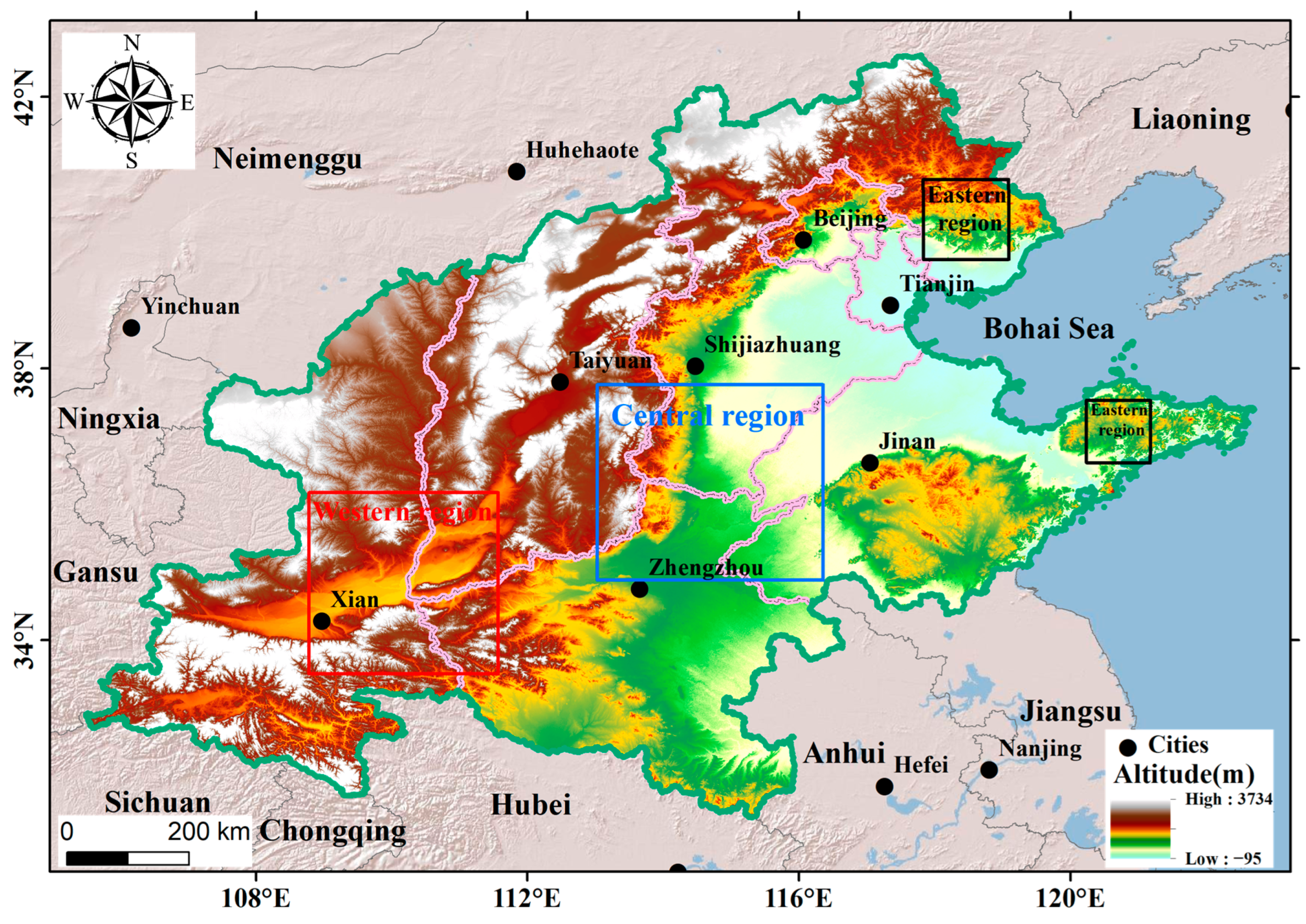


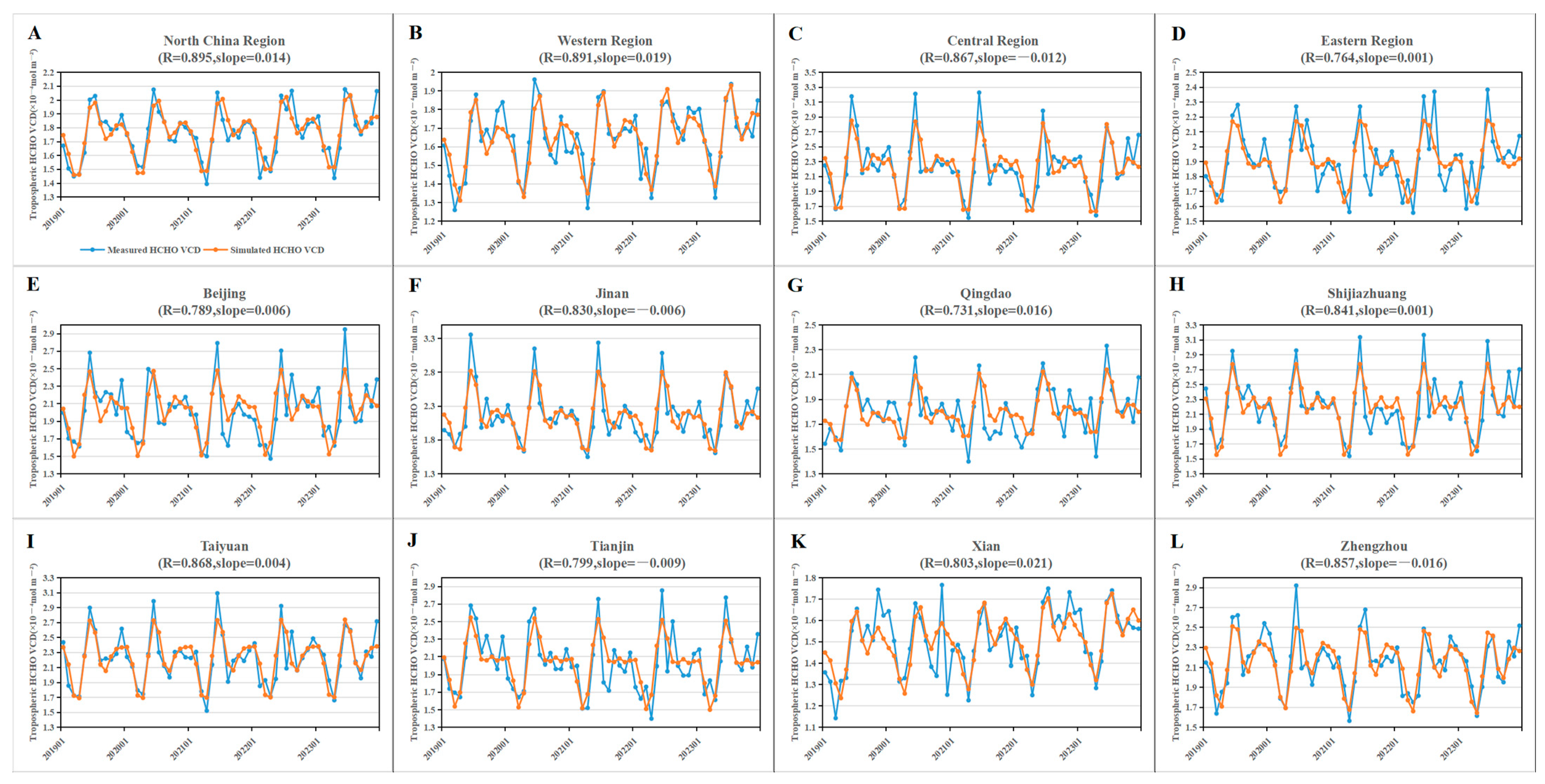
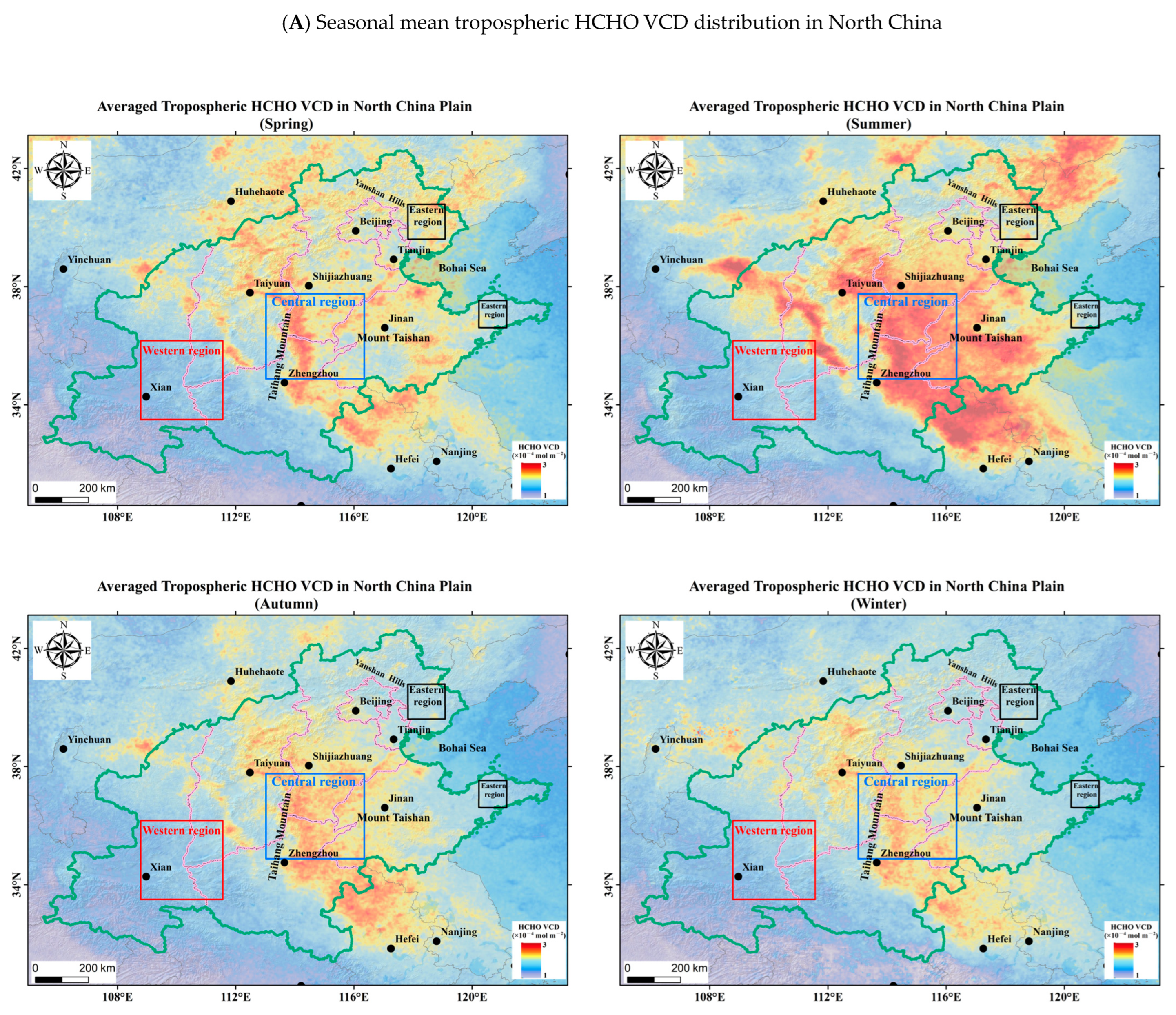

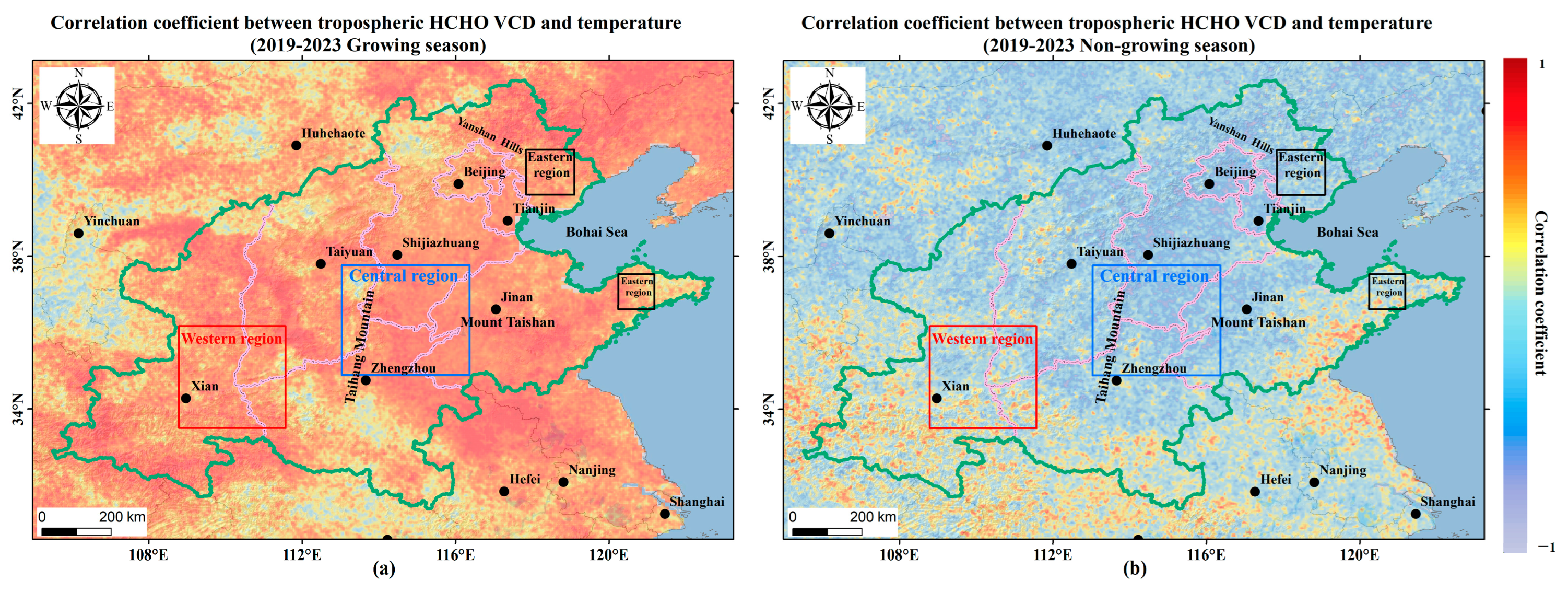
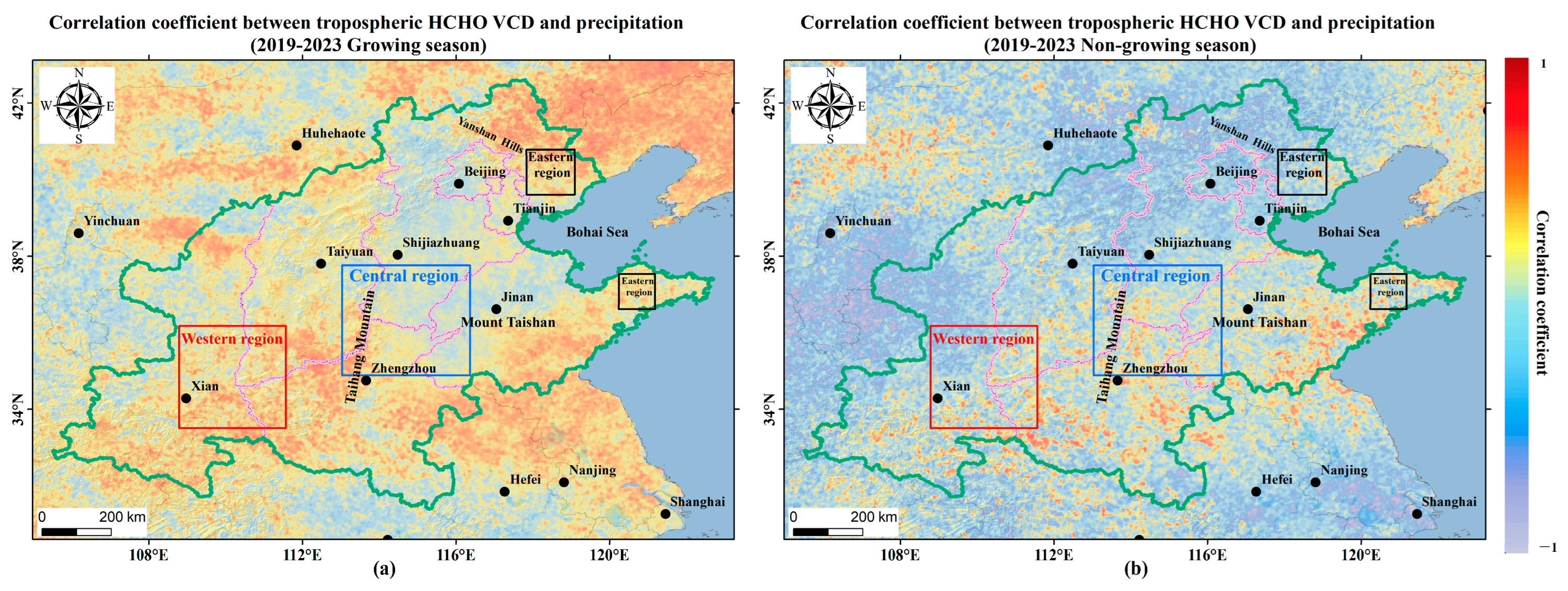
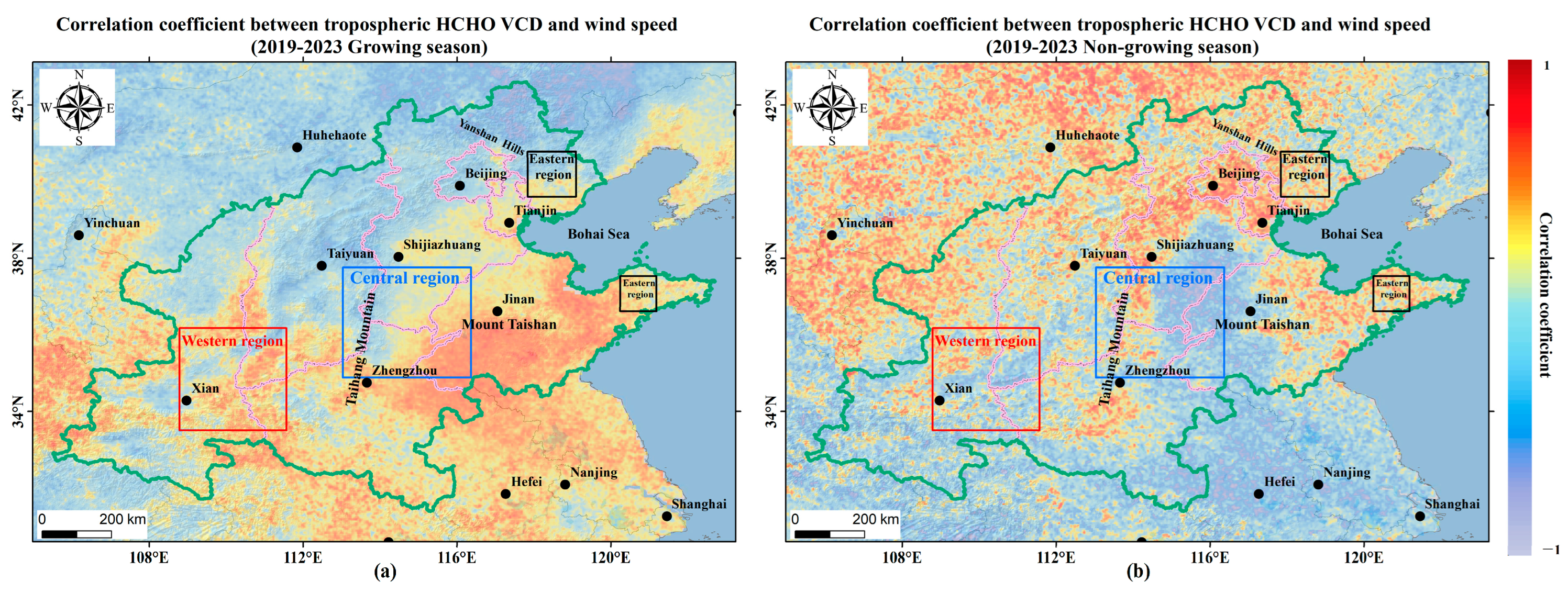


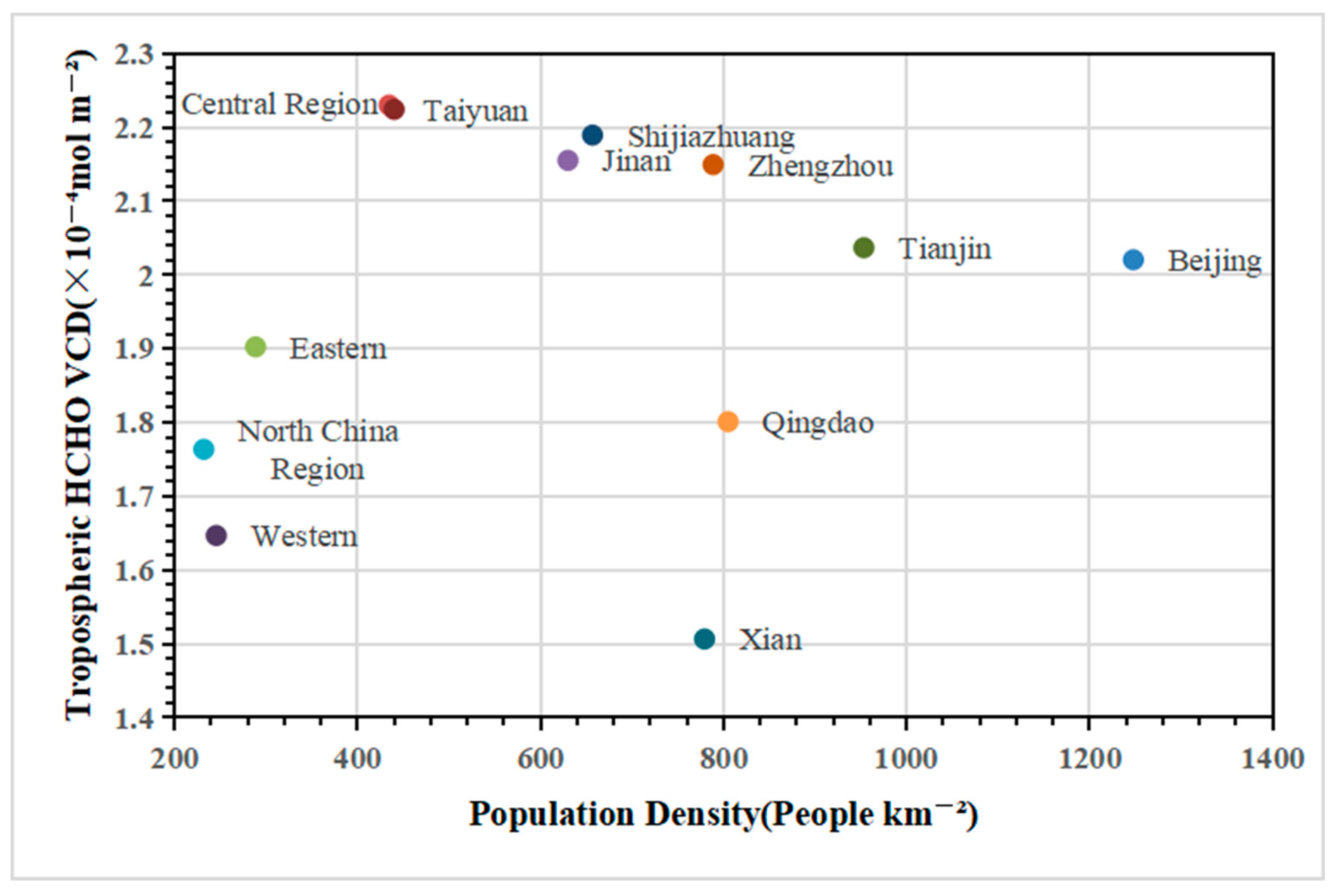
| Region and City Name | Mean Tropospheric HCHO VCD (10−4 mol m−2) | Annual Growth Rate of Tropospheric HCHO VCD (10−6 mol m−2 yr−1) | R | RMSE (10−4 mol m−2) |
|---|---|---|---|---|
| North China Region | 1.76 | 1.37 | 0.90 | 0.08 |
| Western Region | 1.65 | 1.93 | 0.89 | 0.08 |
| Central Region | 2.23 | −1.22 | 0.87 | 0.18 |
| Eastern Region | 1.90 | 0.15 | 0.76 | 0.13 |
| Beijing | 2.02 | 0.61 | 0.79 | 0.20 |
| Jinan | 2.15 | −0.55 | 0.83 | 0.21 |
| Qingdao | 1.80 | 1.63 | 0.73 | 0.13 |
| Shijiazhuang | 2.19 | 0.14 | 0.84 | 0.20 |
| Taiyuan | 2.22 | 0.35 | 0.87 | 0.17 |
| Tianjin | 2.04 | −0.94 | 0.80 | 0.20 |
| Xian | 1.51 | 2.13 | 0.80 | 0.09 |
| Zhengzhou | 2.15 | −1.59 | 0.86 | 0.14 |
| Region and City Name | Temperature | Precipitation | Wind | Net Surface Solar Radiation | NDVI | |||||
|---|---|---|---|---|---|---|---|---|---|---|
| gs | ngs | gs | ngs | gs | ngs | gs | ngs | gs | ngs | |
| North China Region | 0.50 | −0.10 | 0.22 | −0.11 | 0.07 | 0.04 | 0.09 | −0.33 | 0.30 | 0.11 |
| Western Region | 0.54 | −0.04 | 0.30 | −0.06 | 0.24 | −0.01 | 0.03 | −0.29 | 0.40 | 0.24 |
| Central Region | 0.60 | −0.30 | 0.16 | 0.05 | 0.18 | −0.14 | 0.19 | −0.53 | 0.05 | 0.24 |
| Eastern Region | 0.53 | −0.16 | 0.31 | −0.05 | 0.09 | 0.27 | 0.14 | −0.42 | 0.37 | 0.25 |
| Beijing | 0.49 | −0.41 | 0.03 | −0.22 | −0.18 | 0.46 | 0.15 | −0.56 | 0.32 | 0.24 |
| Jinan | 0.63 | −0.29 | 0.12 | 0.05 | 0.39 | −0.19 | 0.30 | −0.53 | 0.15 | 0.20 |
| Qingdao | 0.48 | 0.16 | 0.19 | 0.29 | 0.40 | 0.23 | 0.10 | −0.40 | 0.23 | 0.09 |
| Shijiazhuang | 0.61 | −0.41 | 0.12 | −0.18 | 0.06 | 0.28 | 0.23 | −0.55 | 0.17 | 0.20 |
| Taiyuan | 0.58 | −0.25 | 0.19 | −0.10 | −0.21 | 0.16 | 0.22 | −0.50 | 0.46 | 0.23 |
| Tianjin | 0.59 | −0.33 | 0.15 | −0.22 | 0.28 | 0.44 | 0.24 | −0.54 | 0.33 | 0.24 |
| Xian | 0.52 | 0.03 | 0.28 | −0.04 | 0.12 | 0.03 | 0.04 | −0.13 | 0.28 | 0.09 |
| Zhengzhou | 0.53 | −0.11 | 0.32 | 0.15 | 0.37 | 0.01 | 0.07 | −0.47 | 0.07 | 0.18 |
| Temperature | Precipitation | Wind | Net Surface Solar Radiation | NDVI | Population Density | |
|---|---|---|---|---|---|---|
| HCHO VCD | 0.35 | 0.35 | 0.07 | 0.02 | 0.42 | 0.70 |
Disclaimer/Publisher’s Note: The statements, opinions and data contained in all publications are solely those of the individual author(s) and contributor(s) and not of MDPI and/or the editor(s). MDPI and/or the editor(s) disclaim responsibility for any injury to people or property resulting from any ideas, methods, instructions or products referred to in the content. |
© 2025 by the authors. Licensee MDPI, Basel, Switzerland. This article is an open access article distributed under the terms and conditions of the Creative Commons Attribution (CC BY) license (https://creativecommons.org/licenses/by/4.0/).
Share and Cite
Li, L.; Ma, X.; Chen, D. Spatiotemporal Evolution Characteristics and Drivers of TROPOMI-Based Tropospheric HCHO Column Concentration in North China. Sustainability 2025, 17, 4386. https://doi.org/10.3390/su17104386
Li L, Ma X, Chen D. Spatiotemporal Evolution Characteristics and Drivers of TROPOMI-Based Tropospheric HCHO Column Concentration in North China. Sustainability. 2025; 17(10):4386. https://doi.org/10.3390/su17104386
Chicago/Turabian StyleLi, Li, Xiaodong Ma, and Dongsheng Chen. 2025. "Spatiotemporal Evolution Characteristics and Drivers of TROPOMI-Based Tropospheric HCHO Column Concentration in North China" Sustainability 17, no. 10: 4386. https://doi.org/10.3390/su17104386
APA StyleLi, L., Ma, X., & Chen, D. (2025). Spatiotemporal Evolution Characteristics and Drivers of TROPOMI-Based Tropospheric HCHO Column Concentration in North China. Sustainability, 17(10), 4386. https://doi.org/10.3390/su17104386






